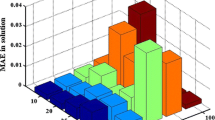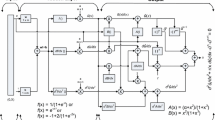Abstract
In this study, a computational intelligence technique based on three different designs of artificial neural networks (ANNs) is presented to solve the nonlinear Troesch’s boundary value problem arising in plasma physics. The structure of three ANN models is formulated by incorporating log-sigmoid (ANN-LS), radial-base (ANN-RB) and tan-sigmoid (ANN-TS) kernel functions in the hidden layers. Mathematical modeling of the problem is constructed for all three feed-forward ANN models by defining an error function in an unsupervised manner. Sequential quadratic programming method is employed for the learning of unknown parameters for all three ANN-LS, ANN-RB and ANN-TS schemes. The proposed models are applied to solve variants of Troesch’s problems by taking the small and large values of critical parameter in the system. A comparison of the proposed solution obtained from these models has been made with the standard numerical results of Adams method. The accuracy and convergence of the proposed models are investigated through results of statistical analysis in terms of performance indices based on the mean absolute deviation, root-mean-square error and variance account for.








Similar content being viewed by others
References
Markin VS, Chernenko AA, Chizmadehev YA, Chirkov YG (1966) Aspects of the theory of gas porous electrodes. In: Bagotskii VS, Vasilev YB (eds) Consultants Bureau, New York, pp 21–33
Gidaspow D, Baker BS (1973) A model for discharge of storage batteries. J Electrochem Soc 120(8):1005–1010
Weibel ES, Landshoff RKM (1958) The plasma in magnetic field. In: Landshoff RKM (ed) A symposium on magneto hydrodynamics. Stanford University Press, Stanford, pp 60–67
Troesch BA (1976) A simple approach to a sensitive two-point boundary value problem. J Comput Phys 21(3):279–290
Temimi H, Kurkcu H (2014) An accurate asymptotic approximation and precise numerical solution of highly sensitive Troesch’s problem. Appl Math Comput 235:253–260
Caglar H, Caglar N, Ozer M (2014) B-spline solution and the chaotic dynamics of Troesch’s problem. Acta Phys Pol A 125(2):554–560
Doha EH, Baleanu D, Bhrawi AH, Hafez RM (2014) A Jacobi collocation method for Troesch’s problem in plasma physics. Proc Roman Acad Ser A 15(2):130–138
Sayfy A, Kafri H, Khoury S (2015) Solution of Troesch’s problem using fixed-point iteration with embedded green’s functions. In: Proceedings of the international conference on numerical analysis and applied mathematics 2014 (ICNAAM-2014), vol 1648, no 1. AIP Publishing, p 050002
Kouibia A, Pasadas M, Belhaj Z, Hananel A (2015) The variational spline method for solving Troesch’s problem. J Math Chem 53(3):868–879
Abo-Hammour Z, Abu Arqub O, Momani S, Shawagfeh N (2014) Optimization solution of Troesch’s and Bratu’s problems of ordinary type using novel continuous genetic algorithm. Discrete Dyn Nat Soc
Momani S, Abuasad S, Odibat Z (2006) Variational iteration method for solving nonlinear boundary value problems. Appl Math Comput 183(2):1351–1358
Feng X, Mei L, He G (2007) An efficient algorithm for solving Troesch’s problem. Appl Math Comput 189(1):500–507
Xi Q, Si J (2014) Existence, uniqueness, and stability analysis of impulsive neural networks with mixed time delays. In: Abstract and applied analysis, vol 2014. Hindawi Publishing Corporation, p 14
Chiu KS, Pinto M, Jeng JC (2014) Existence and global convergence of periodic solutions in recurrent neural network models with a general piecewise alternately advanced and retarded argument. Acta Appl Math 133(1):133–152
Yadav N, Yadav A, Kumar M, Kim JH (2015) An efficient algorithm based on artificial neural networks and particle swarm optimization for solution of nonlinear Troesch’s problem. Neural Comput Appl 1–8. doi:10.1007/s00521-015-2046-1
Yadav N, Yadav A, Kumar M (2015) An introduction to neural network methods for differential equations. Springer, Berlin
Chakraverty S, Mall S (2014) Regression-based weight generation algorithm in neural network for solution of initial and boundary value problems. Neural Comput Appl 25(3–4):585–594
Kumar M, Yadav N (2011) Multilayer perceptrons and radial basis function neural network methods for the solution of differential equations: a survey. Comput Math Appl 62(10):3796–3811
Kumar M, Yadav N (2015) Numerical solution of Bratu’s problem using multilayer perceptron neural network method. Nat Acad Sci Lett 38(5):425–428
Khan JA, Raja MAZ, Syam MI, Tanoli SAK, Awan SE (2015) Design and application of nature inspired computing approach for nonlinear stiff oscillatory problems. Neural Comput Appl 26(7):1763–1780. doi:10.1007/s00521-015-1841-z
Arqub OA, Abo-Hammour Z (2014) Numerical solution of systems of second-order boundary value problems using continuous genetic algorithm. Inf Sci 279:396–415
Abo-Hammour Z, Arqub OA, Alsmadi O, Momani S, Alsaedi A (2014) An optimization algorithm for solving systems of singular boundary value problems. Appl Math Inf Sci 8(6):2809
Mall S, Chakraverty S (2014) Chebyshev neural network based model for solving Lane–Emden type equations. Appl Math Comput 247:100–114
Mall S, Chakraverty S (2015) Numerical solution of nonlinear singular initial value problems of Emden–Fowler type using Chebyshev neural network method. Neurocomputing 149:975–982
Khan JA, Raja MAZ, Rashidi MM, Syam MI, Wazwaz AM (2015) Nature-inspired computing approach for solving non-linear singular Emden–Fowler problem arising in electromagnetic theory. Connect Sci 27(4):377–396
Momani S, Abo-Hammour ZS, Alsmadi OM (2016) Solution of inverse kinematics problem using genetic algorithms. Appl Math Inf Sci 10(1):225
Raja MAZ, Khan JA, Shah SM, Samar R, Behloul D (2015) Comparison of three unsupervised neural network models for first Painlevé transcendent. Neural Comput Appl 26(5):1055–1071
Raja MAZ, Khan JA, Siddiqui AM, Behloul D, Haroon T, Samar R (2015) Exactly satisfying initial conditions neural network models for numerical treatment of first Painlevé equation. Appl Soft Comput 26:244–256
Abo-Hammour ZS, Samhouri AD, Mubarak Y (2014) Continuous genetic algorithm as a novel solver for stokes and nonlinear Navier stokes problems. Math Probl Eng 2014. doi:10.1155/2014/649630
Raja MAZ (2014) Numerical treatment for boundary value problems of pantograph functional differential equation using computational intelligence algorithms. Appl Soft Comput 24:806–821
Ahmad I, Mukhtar A (2015) Stochastic approach for the solution of multi-pantograph differential equation arising in cell-growth model. Appl Math Comput 261:360–372
Raja MAZ, Khan JA, Haroon T (2015) Stochastic numerical treatment for thin film flow of third grade fluid using unsupervised neural networks. J Taiwan Inst Chem Eng 48:26–39
Raja MAZ, Shah FH, Khan AA, Khan NA (2016) Design of bio-inspired computational intelligence technique for solving steady thin film flow of Johnson–Segalman fluid on vertical cylinder for drainage problems. J Taiwan Inst Chem Eng 60:59–75
Raja MAZ, Farooq U, Chaudhary NI, Wazwaz AM (2016) Stochastic numerical solver for nanofluidic problems containing multi-walled carbon nanotubes. Appl Soft Comput 38:561–586
Raja MAZ, Samar R (2014) Numerical treatment for nonlinear MHD Jeffery–Hamel problem using neural networks optimized with interior point algorithm. Neurocomputing 124:178–193. doi:10.1016/j.neucom.2013.07.013
Raja MAZ, Samar R (2014) Numerical treatment of nonlinear MHD Jeffery–Hamel problems using stochastic algorithms. Comput Fluids 91:28–46
Raja MAZ (2014) Solution of the one-dimensional Bratu equation arising in the fuel ignition model using ANN optimised with PSO and SQP. Connection Science 26(3):195–214
Raja MAZ (2014) Numerical treatment for solving one-dimensional Bratu problem using neural networks. Neural Comput Appl 24(3–4):549–561
Raja MAZ, Khan JA, Qureshi IM (2010) A new stochastic approach for solution of Riccati differential equation of fractional order. Ann Math Artif Intell 60(3–4):229–250
Raja MAZ, Manzar MA, Samar R (2015) An efficient computational intelligence approach for solving fractional order Riccati equations using ANN and SQP. Appl Math Model 39(10):3075–3093
Raja MAZ, Khan JA, Chaudhary NI, Shivanian E (2016) Reliable numerical treatment of nonlinear singular Flierl–Petviashivili equations for unbounded domain using ANN, GAs, and SQP. Appl Soft Comput 38:617–636
Raja MAZ, Samar R, Alaidarous ES, Shivanian E (2016) Bio-inspired computing platform for reliable solution of Bratu-type equations arising in the modeling of electrically conducting solids. Appl Math Model 40(11):5964–5977
Raja MAZ, Khan MAR, Mahmood T, Farooq U, Chaudhary NI (2016) Design of bio-inspired computing technique for nanofluidics based on nonlinear Jeffery–Hamel flow equations. Can J Phys 94(5):474–489
Fateh MF, Zameer A, Mirza NM, Mirza SM, Raja MAZ (2016) Biologically inspired computing framework for solving two-point boundary value problems using differential evolution. Neural Comput Appl 1–15. doi:10.1007/s00521-016-2185-z
Raja MAZ (2014) Stochastic numerical treatment for solving Troesch’s problem. Inf Sci 279:860–873
Raja MAZ (2014) Unsupervised neural networks for solving Troesch’s problem. Chin Phys B 23(1):018903
Wang X, Li C, Huang T, Chen L, Wang H (2014) Synchronization criterion for linearly coupled neural networks with impulsive time window. Can J Phys 93(6):610–616
Kwon OM, Park MJ, Lee SM, Cha EJ (2014) Stability analysis for discrete-time neural networks with time-varying delays and stochastic parameter uncertainties. Can J Phys 93(4):398–408
Mathiyalagan K, Sakthivel R, Su H (2013) Exponential state estimation for discrete-time switched genetic regulatory networks with random delays. Can J Phys 92(9):976–986
Badreddine H, Vandewalle S, Meyers J (2014) Sequential quadratic programming (SQP) for optimal control in direct numerical simulation of turbulent flow. J Comput Phys 256:1–16
Garcea G, Bilotta A, Leonetti L (2015) An efficient algorithm for shakedown analysis based on equality constrained sequential quadratic programming. In: Fuschi P, Pisano AA, Weicher D (eds) Direct methods for limit and shakedown analysis of structures. Springer, Switzerland, pp 177–197
Morshed MJ, Asgharpour A (2014) Hybrid imperialist competitive-sequential quadratic programming (HIC-SQP) algorithm for solving economic load dispatch with incorporating stochastic wind power: a comparative study on heuristic optimization techniques. Energy Convers Manag 84:30–40
Durran DR (1991) The third-order Adams–Bashforth method: an attractive alternative to leapfrog time differencing. Mon Weather Rev 119(3):702–720
Misirli E, Gurefe Y (2011) Multiplicative adams Bashforth–Moulton methods. Numer Algorithms 57(4):425–439
Author information
Authors and Affiliations
Corresponding author
Ethics declarations
Conflict of interest
None.
Appendix
Appendix
The values of weights for SQP-ANN-LS, SQP-ANN-RB and SQP-ANN-TS are given in respective Tables 7, 8 and 9 for scenario 1 and in respective Tables 10, 11, and 12 for scenario 2 of Troesch’s problem.
Rights and permissions
About this article
Cite this article
Raja, M.A.Z., Shah, F.H., Tariq, M. et al. Design of artificial neural network models optimized with sequential quadratic programming to study the dynamics of nonlinear Troesch’s problem arising in plasma physics. Neural Comput & Applic 29, 83–109 (2018). https://doi.org/10.1007/s00521-016-2530-2
Received:
Accepted:
Published:
Issue Date:
DOI: https://doi.org/10.1007/s00521-016-2530-2




